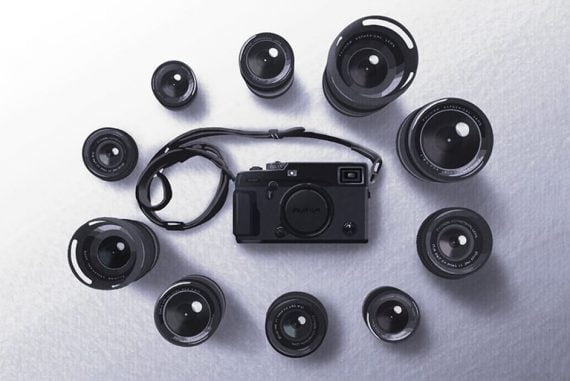
Fuji XF 90mm f/2 Review
Are you looking for a great all-around lens that works equally well for portraits or landscapes? Read on to find out how the Fujifilm XF 90mm fits the bill!
If I were forced to choose two prime lenses to take on a photographic assignment, it would be the 35mm and 135mm focal lengths. In terms of full frame cameras, those have always been my favourites.
In the world of Fuji and their APS-C 24 x 15mm sensors, these focal lengths convert to 23mm and 90mm respectively. In this review I will concentrate on the Fuji XF 90mm f/2 LM WR prime lens.
(If you’re looking for something wider, my review of the Fujinon XF 23mm f/1.4 can be found here.)
The flexibility of the Fuji XF 90mm f/2 LM WR is the primary reason for its appeal.
The inherent shallow depth of field and rapid fall-off in focus directs the viewers’ attention to your subject, making the Fuji XF 90mm f/2 a wonderful portrait lens.
Due to its natural compression, it can also be successfully used to create interesting long lens landscapes.
Fuji 90mm f/2 Review Summary
The biggest selling point of the Fuji 90mm f/2 is its versatility. It shines for both portrait and landscape photography, and is weather and dust resistant. It’s also incredibly sharp, focuses beautifully, and performs exceptionally well wide open. In short, it’s hard to go wrong with this lens.
Fuji XF 90mm f/2 | Specifications
The Fuji XF 90mm f/2 LM WR consists of eleven elements, three low dispersion, in eight groups. It has an angle of view of 17.9 degrees and a minimum focusing distance of 60cm.
The external aperture ring controls the seven-bladed rounded iris in 1/3-stop clicks ranging from f/2 to f/16. The lens weighs 540g and has a filter diameter of 62mm.
Its metal, weather- and dust-resistant shell hides a quad-linear autofocus motor that delivers fast (0.14sec) and accurate autofocus.
The quad-linear motor, designed for the Fuji XF 90mm, employs four magnets for increased torque to shift the larger lens focusing elements of the 90mm.
Ergonomics

Fuji XF 90mm f/2 LM WR.
With its 11cm length (16cm with the included lens hood), Fujifilm designers have been able to give the XF 90mm a very generous 4cm-deep focus ring.
I use manual focus on most occasions and find the torque/resistance of the focus ring very pleasing.
It is smooth and enables fine adjustments, which is essential in telephoto lenses.
If you are an autofocus user, then the focus ring becomes your grip and its bevelled surface removes any chance of the lens slipping in your fingers.
There is little chance of unintentional adjustments given the firm and precise 1/3-stop clicks of the external aperture, in conjunction with it being positioned well away from the focus ring.

Sean Keenan playing John Grant in ‘Wake in Fright’ | 1/500sec at f/5 ISO 3200
Being old school, I’m a firm believer in using a lens hood. I am constantly amazed when I see photographers shooting away sans-lens-protection.
Surely they can’t all be doing it purposefully for the flare or the low contrast ‘look’?
The hood accompanying the Fuji XF 90mm is a substantial 6cm long with inner bevels to increase its efficiency.
I do have one concern with the lens hood which I am checking into with Fujifilm Australia.
After two years of continued use, the hood has become loose and on a number of occasions has disconnected from the lens when brushed by an errant hand or other object.
I imagine this is caused by the softer plastic of the lens hood’s bayonet-style lock wearing down as it is repeatedly twisted on and off the metal lenses.
Fuji XF 90mm f/2 Sample Images
Check out these sample images taken with the Fuji XF 90mm f/2.

Credit: Jeff Carter

Credit: John Rourke

Credit: John Rourke

Credit: Niko Villegas

Credit: Kevin Mullins

Credit: Kevin Mullins

Performance

Jason King in ‘Ghost Hunter’ Documentary | 1/250sec at f/2.5 ISO 2500
First of all, let’s look at the autofocus. The inclusion of the quad-linear autofocus technology results in fast, quiet—and most importantly in a lens with so little depth of field at wider apertures—accurate auto focus.
If you have read any of my previous lens reviews, you’ll know I’m a lover of manual focus. I often find myself shooting in low light, primarily in a studio or at night.
When I do use autofocus in these low-light situations, I find the smallest square in the single point option the most accurate for critical focus.
By using the smallest square, I have also found it reduces ‘focus hunting’ to practically nothing.
Working on film sets is pressure-filled, and speed is of the essence. Actors don’t stand still, and when they do, their heads are always moving as they deliver their dialogue.

Brittany Clark plays Mia Halston in ‘Doctor Doctor’ Series 2 | 1/100sec at f/2 ISO 1000
In these situations, an accurate manual focus system is essential. Fuji has it with its MF Assist / Focus Peak Highlight mode, within which my preference is Yellow/Low.
I can follow and rapidly adjust using manual focus quicker than I can using autofocus. With the peaking option on, I have a backup to my eyes’ ability to see focus through the EVF.
This is essential when shooting in low light.
In my focus test I found the XF 90mm f/2 LM WR at f/2 was lovely and sharp across the majority of the frame.
There is slightly less contrast and sharpness at the far corners of the image. From f/2.2 onwards, the lens is sharp across the image with consistent contrast.

Director Ben Lawrence of the feature documentary ‘Ghosthunter’ | 1/125sec at f/2 ISO 2000
Investigating a lens’s ability to produce a pleasing bokeh (or not) has become part of any review involving all but the widest of lenses.
I converted the image to B+W to be able to primarily concentrate on the shape of these blurred Christmas lights.

At the two widest apertures, f/2 and f/2.2, the circles are even in shape and illumination.
From f/2.5 onwards, the shape of the seven-bladed iris starts to become apparent and of course this shape becomes more defined as you continue to close the lens down.
The evenness of illumination continues to be consistent throughout the aperture range.
How pleasing is the bokeh? Well that surely is in the eye of the beholder.
For me, the roundness of the circles both behind and in front of the plane of focus at f/2 and f/2.2 look lovely, and this is the aperture range I would use whenever possible for this style of image.

In the results I noticed tiny spots within the circles that are evident at all f-stops. I looked at the possible reasons for this and found by process of elimination they were due to dust particles on the rear element of the lens.
So to those of you that love bokeh and shoot with it in mind, I recommend you clean your lenses first.

Nicole De Silva plays Charlie in ‘Doctor Doctor’ Series 2 | 1/500sec at f/5 ISO 800
One of the advantages of shooting wider shots with a longer lens like the Fuji XF 90mm is the ability to work without disturbing your subject.
This becomes a more observational, slice-of-life style of imagery which can work very well as in the photo above of Nicole De Silva during the shooting of ‘Doctor Doctor’.
Fuji XF 90mm f/2 Review | Conclusion

Lee Jones plays Joe Jaffries in ‘Wake in Fright’ | 1/100sec at f/2.8 ISO 1250; Sean Keenan as John Grant in ‘Wake in Fright’ | 1/500sec at f/3.6 ISO 200
My time shooting with this lens has been nothing but positive. The Fuij XF 90mm f/2 LM WR comes with everything I like in a lens of this focal length.
I like the sturdy feel of its weather- and dust-sealed metal exterior, the generous sizing of the focus ring, the firmness of the aperture’s click stops and the meaningful lens hood.
In my opinion the Fuij XF 90mm f/2 LM WR is the best performer, wide open, of all the Fujinon fast prime lenses.
Coupled with the accuracy of either auto or manual focus modes I can confidently shoot at f/2 knowing the results will be sharp and satisfying to look at.
From portraits to landscapes, the Fuji XF 90mm is an extremely versatile lens. That makes it an ideal all-rounder and a good lens to include in any kit I put together, no matter the job brief or destination.
The only thing I don’t love is that its lens hood is plastic.
In my opinion, metal lens hoods should be included across the board, and not just for a select few of the fast primes lenses. That would help give those of us who use these lenses professionally a longer-wearing option to the plastic.














